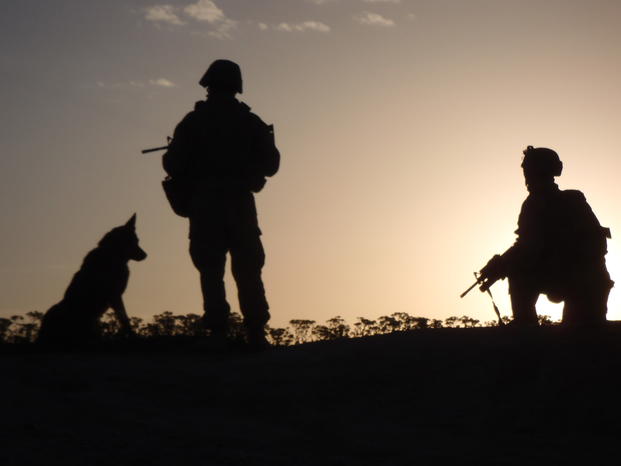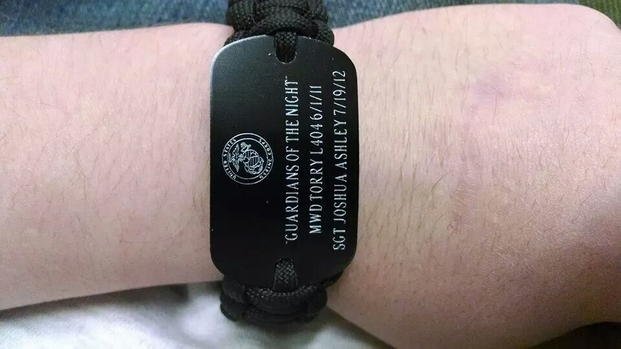Something’s Wrong
Rick Colts knew something was wrong the moment his military working dog changed his search pattern.
It was June 1, 2011, the final patrol before Colts and his German shepherd, Torry, were scheduled to return to Camp Leatherneck for refit ahead of their return home from Afghanistan. A Special Forces team had requested a K9 unit, and Colts and Torry joined them to help secure a site for new base in Helmand Province.
“Torry started working his pattern, and when he starts getting into it, he smells some kind of explosives,” Colts said. “I instantly knew something was up. I held up the patrol; he did his pattern. He went up the right side of the roadway 100 meters, then the left side, then started working his way back.”
The team was conducting a patrol up a roadway that had reportedly been cleared and monitored all night by infrared cameras. Then Torry noticed something.
“I saw his change in behavior, the difference in the way he’s searching,” Colts said. “Now he’s running directly at me, like I was the explosive.” He thought the dog was returning for his reward toy. “He got to me, and sat in front of me staring over at a bush by the side of the road right next to me.”
Before Colts could relay the codeword for explosive ordnance disposal, the IED detonated.
“The only reason I’m still alive is Torry was between me and the bomb,” Colts said. “It blew up through him, it threw bones, rocks, metal into me, knocked me from one side of the road to the other, off the road.”
From California to Combat: A Marine K9 Handler’s Journey
Colts, born in 1988, lived across multiple states before finishing high school in Fall River Mills, California. Military service was his destiny. His grandfather was a Marine, his great-grandfather served in the Seabees, and his uncle trained dogs in the Air Force.
“I always knew I’d join,” Colts said. “It put me on the path. I always knew, because of family.”
He left for the Marine Corps Recruit Depot San Diego 10 days after high school graduation in June 2007. After completing military police officer training at Fort Leonard Wood, Colts competed for one of the coveted K9 handler slots, requiring high physical fitness test scores and passing a selection board.
His uncle’s service inspired him to pursue the K9 handler specialty, and he was one of the few selected to train military working dogs. Although he always had dogs growing up, the training at Lackland Air Force Base in Texas prepared him for the unique demands of working with dogs in a military capacity.
“Being a Marine on an Air Force Base is the greatest thing ever,” he joked.
Upon completing the training, Colts was assigned to II Marine Expeditionary Force Headquarters Group at Camp Lejeune.

Military Working Dogs in Iraq and Afghanistan
Military working dogs played a massive role in World War II, hauling ammunition, guarding bases, and helping detect enemy troops. During the Vietnam War, military canines proved vital to finding enemy supply caches and detecting enemies in the jungle. Following this, they were slowly downsized across the military over the next three decades.
Military dogs were again called upon and served crucial roles in both Iraq and Afghanistan, detecting improvised explosive devices that became the signature weapons faced by Coalition troops in both conflicts. These specialized canines and their handlers conducted route clearances, vehicle searches, and building entries, often working ahead of infantry patrols to identify hidden explosives. Around 100 American military working dogs were killed while engaging the enemy during the Global War on Terrorism.
Colts deployed to Iraq in 2009 with his first military working dog, Aja, an all-black German shepherd. Stationed at bases including Baharia outside Fallujah, Al Taqaddum, and Al Asad, the team conducted gate security, route clearances, and searches of government buildings during what Colts described as Iraq’s cooling-down period.
Aja was high-energy and strong-willed, an excellent search dog who loved to work.
During one mission searching a Fallujah government building, an Iraqi general became enraged about the dog’s presence. Black dogs carry a particular stigma in some Middle Eastern cultures.
“He came over yelling and screaming, very unhappy about us searching the building,” Colts said. “Dogs are dirty in their culture. There’s a stigma with dogs, especially black dogs. I was trying to get the interpreter to calm him down. The guy went to grab me, and Aja snatched his arm and started whipping him side to side. Then the dude ran back in the building.”
Colts received a reprimand from his captain, but the dog had performed exactly as trained, protecting her handler from an aggressive approach.
The seven-month Iraq deployment proved frustrating for a different reason. “We searched thousands and thousands of vehicles on a daily basis,” Colts said.
The handlers had to routinely plant items for their working dogs to find so that their morale didn’t falter. Boredom and complacency became a daily battle for the team.
When they returned to Camp Lejeune, Aja was reassigned to another handler. Colts watched others work with his former partner, and it was difficult to see the training he’d put into her not being fully utilized.

Meeting Torry
After returning from Iraq and completing a leadership course, Colts was assigned a new partner.
“He was a beast,” Colts said of Torry, a traditional brown-and-black German shepherd. “Smart dog, not great at attacking. He would, but it wasn’t his thing. But he looked very aggressive. He had one broken ear that flopped to the side.”
Torry earned the nickname Houdini for repeatedly escaping his kennel and breaking into other dogs’ enclosures. On Colts’ first day on duty with him, Torry broke out and locked himself in his girlfriend’s kennel. The kennel staff resorted to using padlocks.
The 2010-2011 Afghanistan deployment was the opposite of Iraq. Colts and Torry conducted constant patrols throughout Helmand Province, sometimes twice daily. They worked with various infantry units and two different Special Forces teams, walking ahead of patrols to clear roadways of IEDs.
Helmand Province was a vicious battleground during that time as the Marines tried to wrest control of the region from the Taliban. IEDs were a daily occurrence for the Marines, casualties mounted. K9 teams, like Colts and Torry, worked tirelessly to combat them and protect the infantry.

Torry’s Sacrifice
Colts woke on the other side of the road, disoriented. He couldn’t open his eyes. His corpsman, concerned about secondary IEDs, called out for Colts to navigate to him by sound. Pumped full of morphine, Colts was loaded onto a helicopter and evacuated from the battlefield.
“I asked the guys where my dog was and to get my dog,” Colts said. “It wasn’t until I woke up in the hospital that my gunny told me Torry was dead. I had been evacuated and was headed home.”
The emotional toll was immediate.
“Heartbroken,” Colts said. “I was thinking, did I do something wrong? Did he? Was it something we did? Was anyone else injured? The idea I got someone blown up went through my head. It’s one thing for it to be me, another for someone else.”
Only Colts and his machine gunner, who took minor shrapnel wounds, were wounded in the blast. Torry was Killed in Action.
Doctors removed pounds of muscle from Colts’ legs, arms, and chest. His body armor absorbed much of the damage, but he initially faced amputation of his left hand and left leg, as well as the loss of one of his eyes.
“I told them to leave it all in place, nothing gone,” Colts said. “They argued. I made my feelings clear. They told me I’d never live without pain or walk again.”
Over 15 days, Colts underwent approximately 20 surgeries. A month passed before he could return to his unit at Camp Lejeune on light duty. He made an impressive recovery, but walked with a cane for three months and continues to live with chronic pain and nerve damage.
He remained in the Marine Corps for nearly another year before separating on June 25, 2012, as a corporal. His awards include the Purple Heart and numerous deployment medals.
Torry’s name was placed on a memorial plaque in Afghanistan honoring him and another fallen K9, along with both of the wounded handlers.

Searching for Purpose After Service
After leaving the Marines, Colts considered law enforcement. But in 2012, he returned to Iraq as a contract K9 handler at the U.S. Embassy in Baghdad.
The experience was disappointing. Many of his fellow contractors were police officers, not military veterans, and Colts worried the dogs weren’t properly trained for serious threats. Building a rapport with the contract dogs proved difficult after losing Torry.
“It wasn’t the same,” he said.
After his time in Baghdad, Colts returned stateside and changed directions. He attended the University of South Florida and earned degrees in geology and environmental science. Today, he works as a hydrogeologist in Florida, specializing in underground water systems.
He’s married and raising two children: his 18-year-old brother and 12-year-old son. His younger brother plans to join the Marines as an infantryman after graduation.
Their family includes another important member: Atlas, a golden retriever.
“It means everything to me, there’s been times we didn’t have [a dog], it’s the emptiest I can feel,” Colts said. “Having a dog here, to give everything I wish I could have given to Torry, a safe home, a happy life, it means a lot.”

The Bond Between Handler and Dog
“They’re kind of your partner, kind of your best friend,” Colts said of the handler-K9 relationship. “They are there for everything. Your life is in their hands, and theirs is in yours. But they are Marine Corps equipment. At the end of the day, they belong to the Marine Corps, just like a weapon. If they want to take it, they can. You still build quite a thick relationship with them.”
Most civilians remain unaware that military working dogs exist beyond high-profile operations like the Osama bin Laden raid, Colts noted. Fellow service members who served alongside Colts and Torry occasionally reach out to share stories and express condolences.
“It’s a great experience,” Colts said.

A Veteran Living for Two
Colts carries Torry’s memory through action rather than words. He tries to live his life to the fullest, stay active in the community, and enjoy time with his golden retriever, Atlas.
The physical limitations persist, but Colts refuses to let pain define his existence. When asked what he wants Torry remembered for, Colts’ answer is simple and absolute.
“For being a badass,” Colts said. “He did a great job while over there, saved many lives.”
The Marine Corps remains central to Colts’ identity despite his transition to civilian life.
“The Marine Corps is family. It’s who I am,” Colts said. “Doesn’t matter who I am, or that I graduated from some big colleges, did a lot in the field. At the core of who I am, I’ll always be a Marine.”

On June 1, 2011, on a roadside in Helmand Province, Torry detected a threat, alerted his handler, and positioned himself between Colts and the bomb. The dog absorbed the blast that would have killed the Marine.
Colts lives with chronic pain and will carry that in his body for life. But he walks. He works. He raises his family. He spoils his golden retriever.
And he remembers the Marine Corps dog who gave him that chance.
Story Continues
Read the full article here





